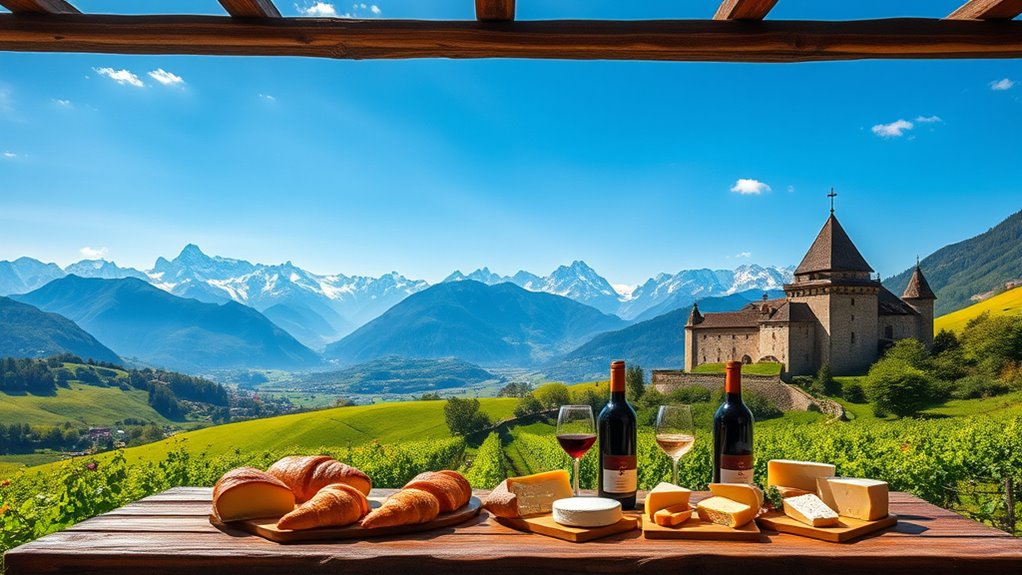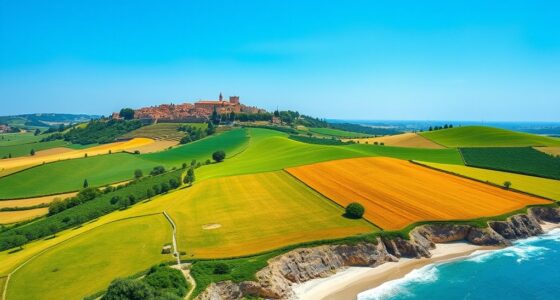Aosta Valley enchants you with its stunning mountain landscapes and charming alpine settlements. You’ll find historic castles that tell tales of the region’s rich past. Savor gourmet mountain cuisine, featuring traditional dishes like fondue and polenta, all infused with French-inspired flavors. Explore ancient Roman ruins and vibrant cultural festivals that connect you to the local community. There’s so much more to discover about this breathtaking destination, so keep exploring to uncover its hidden gems.
Key Takeaways
- Aosta Valley boasts stunning mountain landscapes, perfect for outdoor activities and breathtaking views throughout the year.
- Historic castles, such as the Castle of Fenis and Sarre Castle, showcase the region’s rich architectural heritage.
- The local cuisine features French-inspired flavors, highlighted by dishes like fondue and polenta, complemented by Fontina PDO cheese.
- Artisan chocolate tastings and unique local herbs enhance the culinary experience, with events like the Art & Ciocc Festival celebrating these delights.
- Explore ancient Roman ruins, including the Arch of Augustus and the Roman Theater, that reflect Aosta’s historical significance and charm.
Breathtaking Mountain Landscapes Await
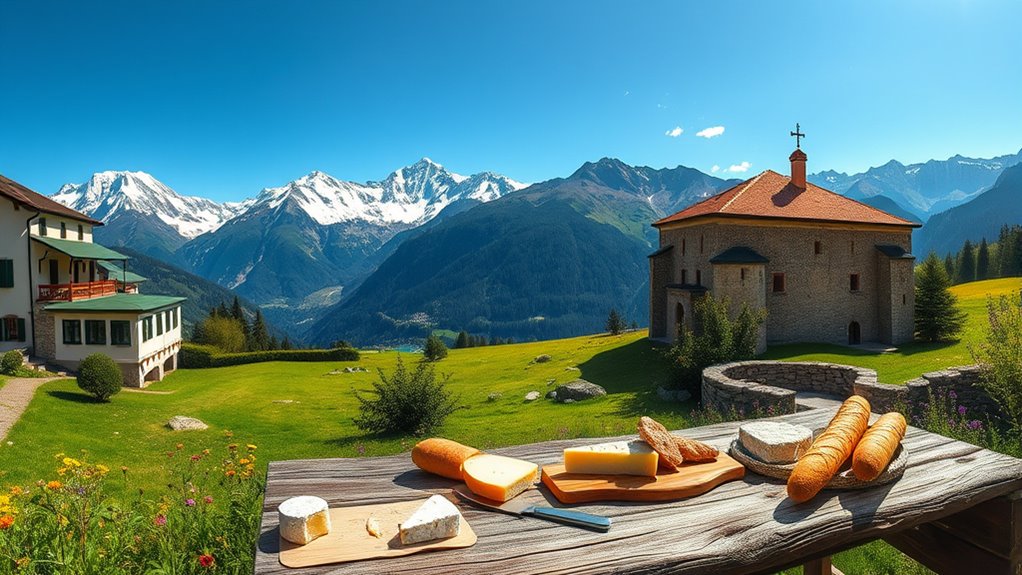
As you explore the breathtaking mountain landscapes of Aosta Valley, you’ll discover not just stunning views but also rich culinary traditions.
The high-altitude pastures provide the perfect environment for flavorful cheese and hearty polenta, both staples of the local cuisine.
Embrace the flavors that these majestic mountains have to offer while soaking in the beauty around you. Additionally, the region’s emphasis on whole, unprocessed foods enhances the culinary experience, reflecting a commitment to quality and nutrition.
Savory Cheese and Hearty Polenta
In the Aosta Valley, the combination of savory cheese and hearty polenta creates a culinary experience that’s as rich as the breathtaking mountain landscapes surrounding you.
You can’t visit without savoring Fontina PDO, renowned for its milky aroma and creamy texture, crafted from local cow’s milk within hours of milking. Served alongside traditional polenta, made from cornmeal and simmered slowly to perfection, this dish embodies comfort and tradition.
Pair it with game meats or wild mushrooms to enhance the flavor. Each bite reflects the valley’s unique alpine pastures, where the cattle graze on rich grasses.
Together, these ingredients celebrate the region’s culinary heritage, inviting you to indulge in a truly authentic Aosta Valley experience. Additionally, the region’s love for savory cheese has influenced various local dishes, showcasing its versatility in different culinary contexts.
Charming Alpine Settlements
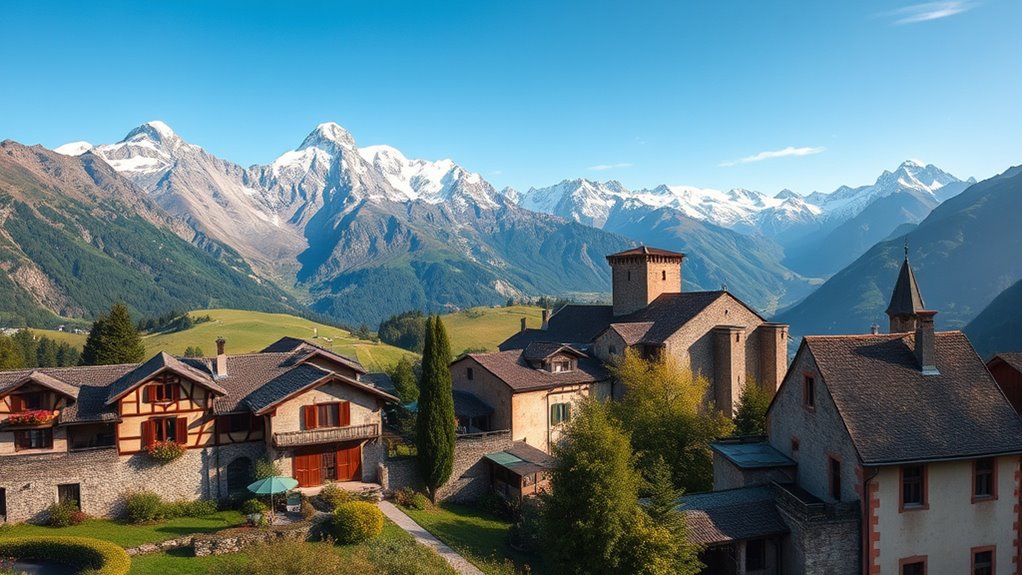
When you explore the Aosta Valley, you’ll find charming alpine settlements that offer a glimpse into the region’s unique lifestyle.
From secluded villages nestled in the mountains to regional transportation centers connecting you to various attractions, there’s a lot to discover.
Don’t forget to try the local mountain herbs that add a special touch to the area’s cuisine! Additionally, the influence of French-inspired flavors can be seen in many local dishes, enhancing the culinary experience.
Regional Transportation Centers
Nestled in the stunning Aosta Valley, charming alpine settlements serve as key regional transportation centers, making it easy for you to explore this picturesque area.
The Aosta city hub offers frequent train services to Turin and connects to an extensive bus network operated by SVAP, which includes 20 routes and 328 bus stops.
You’ll find the longest bus route spans over 26 km from Aosta to Cogne. For ski enthusiasts, cable cars provide direct access to nearby resorts.
Private transfers, including taxis and car hires, ensure personalized transport options. With major road networks like the A5 motorway and connections to international airports, navigating the Aosta Valley couldn’t be more convenient.
Additionally, the region’s extensive bus network enhances accessibility, allowing visitors to easily reach various attractions throughout the valley.
Enjoy seamless travel as you uncover the valley’s beauty!
Secluded Alpine Villages
The Aosta Valley is home to a collection of secluded alpine villages that offer a glimpse into a charming and tranquil way of life.
Nestled among towering peaks, these villages showcase unique architecture and rich history. When you visit, be sure to explore:
- Bard: Discover its medieval fort and the fascinating Alps Museum, revealing the region’s strategic past.
- Étroubles: Stroll through this picturesque village, famous for its stone houses and enchanting mountain charm.
- Avise: Marvel at the 15th-century castle and the historic Château de Blonay, which highlight the area’s feudal heritage.
Each village invites you to experience the breathtaking beauty and cultural richness of the Aosta Valley. Additionally, the region’s strategic past is reflected in its historic sites and architecture, enriching your visit.
Enjoy the tranquility and warmth of these hidden gems!
Try Local Mountain Herbs
In Aosta Valley’s charming alpine settlements, you’ll find a treasure trove of local mountain herbs that elevate the region’s culinary offerings.
Gentian, with its vibrant roots, adds depth to liqueurs and amaro recipes. You’ll notice juniper’s distinctive flavor in dishes and drinks, thanks to its diuretic properties.
Don’t miss the chance to taste Genepy, made from glacier wormwood, a true alpine specialty. Hyssop, introduced by Benedictine monks, not only flavors liqueurs but also aids respiratory health.
You can even explore herb cultivation through tours at the Centro Agricolo of Saint Michel.
From herbal teas to unique preserves, these mountain herbs infuse Aosta Valley’s cuisine with rich tradition and flavor, making your culinary experience unforgettable. Additionally, incorporating digestive health benefits of these herbs can further enhance your overall well-being.
Gourmet Mountain Cuisine

When you explore Aosta Valley, you can’t miss the hearty fondue and rich risotto that showcase the region’s flavors. Pair these dishes with local grapes from nearby distilleries for a true taste of the mountains. Don’t forget to treat yourself to artisan chocolate tastings that perfectly complement your culinary adventure! To enhance your experience, consider trying global flavors that reflect the diverse culinary influences found in the region.
Hearty Fondue and Rich Risotto
What could be more delightful after a day on the slopes than indulging in a warm, hearty fondue or a rich risotto? In the Aosta Valley, these dishes embody the essence of comfort and flavor, perfect for a cozy evening.
- Fondue: Made with Fontina cheese, milk, and egg yolks, it’s often enjoyed with croutons or potatoes in a communal setting, enhancing the social experience.
- Rich Risotto: Featuring local ingredients like Fontina and mountain herbs, this creamy dish highlights the region’s natural flavors.
- Pairing Suggestions: Enjoy these delights with local wines or elevate your fondue experience by adding truffles for an extra layer of flavor. Additionally, consider using energy-efficient appliances to prepare these dishes, enhancing your kitchen experience while being eco-friendly.
Treat yourself to these alpine culinary treasures!
Regional Grapes and Distilleries
After savoring the hearty flavors of fondue and risotto, your culinary journey in the Aosta Valley can continue with the region’s remarkable wines and spirits. Here, you’ll discover unique grape varieties like Petite Arvine and Fumin, along with local distilleries crafting exquisite spirits.
| Grape Variety | Key Characteristics | Notable Appellation |
|---|---|---|
| Petite Arvine | Minerality, floral aromas | Valle d’Aosta DOC |
| Fumin | Smoky, full-bodied | Torrette DOC |
| Petit Rouge | Tart, fruity | Enfer d’Arvier DOC |
| Prié Blanc | Minerally, floral | Blanc de Morgex et de La Salle DOC |
| Cornalin | Diverse wine styles | Valle d’Aosta DOC |
Pair these wines with local dishes to enhance your experience in this beautiful alpine region. The region’s culinary offerings are reminiscent of cucina povera, showcasing the resourcefulness of local chefs.
Artisan Chocolate Tastings
Indulging in artisan chocolate tastings is a must for any visitor to the Aosta Valley.
You’ll discover a delightful world of flavors that combines local ingredients with traditional methods.
Don’t miss these highlights:
- Art & Ciocc Festival: Experience this annual event in Aosta’s Piazza Chanoux, featuring chocolate tastings, sculptures, and local specialties.
- Unique Pairings: Savor innovative combinations, like chocolate with local beer, fruit skewers, and distillates, crafted for an unforgettable experience.
- Health-Conscious Options: Enjoy gluten-free, vegan, and raw chocolates that cater to all dietary preferences while ensuring deliciousness. Additionally, indulging in protein-rich options like the Egg Rollup can enhance your breakfast experience before diving into the world of chocolate.
With renowned chocolatiers and their creative offerings, the Aosta Valley is an epicurean paradise that every chocolate lover will cherish.
Must-See Sights

When you explore Aosta Valley, you can’t miss the ancient Roman ruins that tell stories of the past.
Majestic glacial lakes offer stunning views and perfect spots for relaxation.
Plus, experiencing local cultural festivals and traditions adds an unforgettable touch to your visit, especially during the vibrant autumn harvest.
Ancient Roman Ruins
As you explore the Aosta Valley, you’ll quickly discover why it’s often called the “Rome of the Alps,” thanks to its remarkable ancient Roman ruins.
These well-preserved sites offer a glimpse into the region’s rich history. Here are three must-see highlights:
- Arch of Augustus: This impressive arch celebrates the founding of Aosta and the defeat of the Salassi tribe.
- Roman Theater: Built during Augustus’s reign, this stunning structure features a towering 22-meter-high facade and hosts cultural events today.
- Porta Praetoria: The eastern gateway to the city, made from stone and slate, is a popular spot for photos and exploration.
Don’t miss these incredible pieces of history as you wander through this captivating valley!
Majestic Glacial Lakes
The Aosta Valley is home to some of the most breathtaking glacial lakes in the Italian Alps, each offering a unique slice of nature’s beauty.
You’ll find Lake Verney, the largest in La Thuile, with its crystal-clear waters teeming with aquatic life. Lake Miage dazzles with its shifting colors, while the calm waters of Lake Arpy are embraced by picturesque meadows.
For a serene escape, visit Lac Combal, surrounded by towering mountains, or hike to Lac Chécrouit for stunning vistas. Many lakes are accessible by car or well-marked trails, especially during the warmer months.
Whether you’re into photography, fishing, or simply enjoying a picnic, these glacial gems are perfect for nature lovers and adventurers alike.
Cultural Festivals and Traditions
Cultural festivals in the Aosta Valley offer a vibrant glimpse into the region’s rich heritage and traditions.
You’ll find a variety of events that showcase local customs, crafts, and flavors:
- Battaglia della Regina: Watch cows engage in playful battles every Sunday from March to October in Aosta.
- Fiera di Sant’Orsola: Explore this January fair featuring exceptional local craftsmanship, including wood and iron work.
- Festa del Lardo: Savor the Valdostan lard at this August festival in Arnad, honoring a beloved local delicacy.
These festivals highlight the community’s connection to its history and its commitment to preserving unique traditions.
Be sure to immerse yourself in the lively atmosphere and taste the authentic flavors of the Aosta Valley!
Visit During Autumn Harvest
If you’re planning a visit to the Aosta Valley during the autumn harvest, you’re in for a treat with stunning sights and seasonal delights.
Experience the oldest chestnut festival in late October, where you can indulge in tastings and competitions celebrating this local delicacy.
Marvel at the breathtaking fall foliage as you hike through Gran Paradiso National Park or take in the views from Mont Blanc.
Don’t miss the medieval charm of Fénis Castle and Bard Fortress, offering panoramic landscapes.
Join a chestnut harvest tour at the Il Riccio cooperative in Lillianes for an insider’s look at chestnut processing.
Enjoy the local cuisine, featuring chestnut-based dishes, Fontina cheese, and exquisite wines from nearby vineyards.
Practical Tips
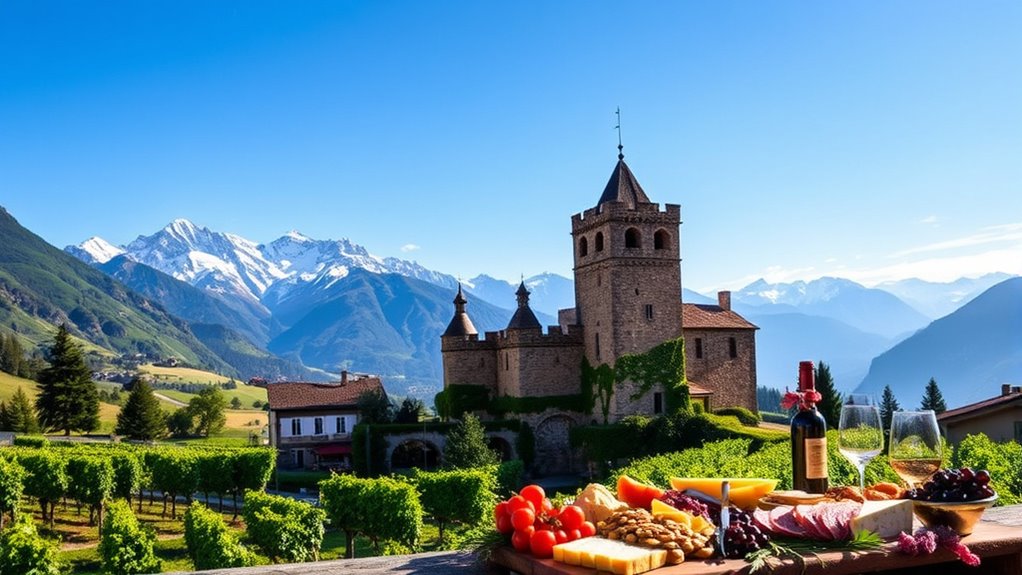
When planning your trip to Aosta Valley, knowing how to get there and get around is crucial.
You’ll want to consider the best time to visit for your interests and find the right place to stay.
Plus, understanding local etiquette will enhance your experience in this beautiful region.
Getting There
Getting to Aosta Valley is easier than you might think, thanks to various transport options that cater to different preferences and budgets.
Here are three great ways to reach this stunning region:
1. By Air: Fly into Turin or Malpensa airports. From Malpensa, take a train to Aosta, which takes about 3.5 hours.
Aosta Airport also offers exclusive flights to the Alpine peaks.
2. By Train: Catch a train from Turin, with frequent services taking less than two hours to Aosta Station, conveniently located near the historic center.
3. By Bus: Enjoy daily bus services from Milan and other key locations.
The extensive SVAP bus network covers much of Aosta Valley, providing a stress-free travel experience.
Getting Around
Exploring Aosta Valley is a breeze with its reliable transport options. Daily bus services connect Aosta with key locations like Cervinia and Courmayeur, running every 30-40 minutes. You can buy tickets before boarding or onboard from authorized retailers.
If you prefer trains, the railway from Chivasso offers scenic views and connects Turin to Aosta in under two hours. For those driving, the A5 highway provides easy access, though be cautious of narrow roads and winter conditions; rental cars are available.
Alternatively, consider private transfers for a luxurious experience, complete with knowledgeable drivers. Local urban buses and a mobile app help you navigate Aosta and surrounding areas effortlessly.
Enjoy your journey!
Best Time to Visit
To truly enjoy the Aosta Valley, timing your visit can make all the difference. Each season offers unique experiences, allowing you to tailor your trip to your interests. Here are the best times to visit:
- Spring (March to May): Enjoy mild weather and blooming landscapes, perfect for biking without the summer crowds.
- Summer (June to August): Experience vibrant festivals and all trails open for hiking and biking, but be prepared for peak tourist crowds.
- Autumn (September to November): Witness breathtaking fall colors and a cooler climate, ideal for leisurely outdoor activities with fewer tourists.
Consider your outdoor preferences and desired experiences to choose the perfect time for your Aosta Valley adventure!
Where to Stay
When planning your stay in Aosta Valley, you’ll find a variety of accommodations that cater to different tastes and budgets.
Choose from boutique hotels blending Nordic and Alpine styles, cozy traditional chalets, or charming converted farms for a unique experience. For families, family-run hotels offer warm hospitality with stunning mountain views.
If luxury’s your preference, consider ski-in/ski-out resorts in Courmayeur or modern hotels in La Thuile. Budget options include cozy B&Bs, guesthouses, and even local hostels.
Many accommodations provide amenities like wellness centers, guided activities, and free Wi-Fi. To ensure the best experience, use online booking platforms like Booking.com and check guest reviews for insights on comfort and service quality before making your reservation.
Local Etiquette
Understanding local etiquette in Aosta Valley can enhance your travel experience significantly, as it reflects the region’s rich culture and traditions.
Being aware of local customs will help you connect with the community and make lasting memories. Here are a few practical tips:
- Greetings: Use formal titles like “Signore” or “Signora” when meeting locals. A polite greeting goes a long way.
- Dining Etiquette: Keep your hands visible on the table and savor mealtimes. Enjoy local specialties like fondue and polenta.
- Environmental Respect: Be mindful of nature—dispose of waste properly and support local conservation efforts to preserve the stunning surroundings.
Embracing these etiquette practices will enrich your visit to this beautiful alpine region.
Pro Tip
How can you make the most of your trip to Aosta Valley? First, plan your visit during winter for skiing or summer for hiking.
Choose accommodations that fit your style, from luxurious hotels to cozy B&Bs. Renting a car is ideal for exploring, but public transport is also efficient.
Since both Italian and French are spoken widely, learning a few basic phrases can enhance your experience. Dress in layers to adapt to changing weather, and always carry waterproof clothing.
Don’t miss Gran Paradiso National Park for stunning wildlife and hiking trails.
Finally, indulge in local cuisine—try the fondue, polenta, and delicious hot chocolate to truly savor Aosta Valley’s flavors.
Frequently Asked Questions
What Is the Best Time to Visit Aosta Valley?
The best time to visit Aosta Valley depends on what you’re looking for.
If you enjoy outdoor activities, spring and summer are ideal with mild weather and plenty of sunshine.
Autumn offers stunning foliage and local traditions, while winter is perfect for skiing and snow sports.
To avoid crowds, consider visiting in May or late September to October.
Each season brings unique experiences, so choose based on your interests!
Are There Any Local Festivals or Events in Aosta Valley?
Yes, you’ll find plenty of local festivals and events in Aosta Valley.
You can experience the Sant’Orso Fair in January, showcasing traditional crafts, or enjoy the wine and food at the Viva Valle d’Aosta in September.
If you’re into music, the Celtica Music Festival in July is a must.
Don’t miss the Sarre Cheese Festival for delicious tastings!
Each event offers a unique glimpse into the region’s rich culture and heritage.
How Do I Get to Aosta Valley From Turin?
To get to Aosta Valley from Turin, you’ve got several options.
You can take a FlixBus, which runs every 4 hours, taking about 1 hour and 30 minutes for €11–16.
Alternatively, consider the train, which takes around 2 hours and 58 minutes, with tickets starting at $14.
If you prefer driving, it’s roughly a 1-hour drive.
Carpooling is also an option, typically taking about 1 hour and 20 minutes.
What Outdoor Activities Are Available in Aosta Valley?
In Aosta Valley, you’ll find a wealth of outdoor activities to enjoy.
You can hike through Gran Paradiso National Park, cycle along the Great Saint Bernard Pass, or ski at one of the many resorts.
If you’re looking for a thrilling winter experience, try snow biking or paragliding.
Don’t miss the stunning views from the Mont Blanc Skyway or the serene beauty of Lac Blue for an unforgettable day outdoors.
Is Aosta Valley Suitable for Families With Children?
With over 600 kilometers of family-friendly trails, Aosta Valley’s perfect for families with children.
You’ll find kid-friendly accommodations and outdoor play areas that cater specifically to your needs.
Seasonal activities like skiing in winter and hiking in summer keep everyone engaged.
Plus, you can explore fascinating castles and learn about local culture through hands-on experiences.
Aosta Valley offers a blend of adventure and education, ensuring your family has a memorable vacation.
Conclusion
So, if you’re ready to trade your mundane routine for some breathtaking views, charming villages, and gourmet delights, the Aosta Valley’s calling your name. Forget about that overpriced coffee shop down the street; why not sip a rich espresso surrounded by majestic mountains instead? Who needs the hustle and bustle of the city when you can explore historic castles and savor French-inspired flavors? Grab your gear, and let’s make your Instagram followers jealous—because, really, isn’t that what travel’s all about?

